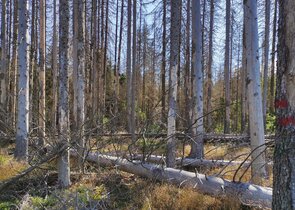Game Management in the Šumava/Bohemian Forest Mts. National Park

Since establishing the Šumava/Bohemian Forest Mts. National Park (hereinafter ŠNP) in 1991 game and its management have been an important part of forest management there. The first NP’s Management Plan (Kučera et al. 1992) dealt extensively with the issue. According to its authors, Red deer (Cervus elaphus) numbers were extremely high within the whole NP and keeping and breeding of trophy game was preferred. Moreover, it was clear at that time that due to red deer’s migratory behaviour its management should not be limited only to the NP’s territory but it should be connected with that on the entire Protected Landscape Area’s territory as well as with the whole Šumava/Bohemian Forest Mts. foothills including the Bavarian side.
Nature Conservation 2024 — 30. 5. 2024 — Nature and Landscape Management — Print article in pdf
European Spruce Bark Beetle Plague in the Jeseníky Mts. Protected Landscape Area – the Story (Most P

According to experts, the current European spruce bark beetle (Ips typographus) plague is unprecedentedly the greatest in the Czech Republic’s history: it avoids neither the Jeseníky Mountains Protected Landscape Area (PLA,) in northern Moravia). In the time full of changes and twists, it has generated a number of issues and questions for forest managers, nature conservationists, and the general public; it stirs emotions and it is the subject of media discussions, where opinions are often mistaken for facts. The aim of this article is to take a closer look at the course of the European spruce bark beetle outbreak in recent years in the Jeseníky Mts. PLA, primarily through specific numbers.
Nature Conservation 2024 — 30. 5. 2024 — Nature and Landscape Management — Print article in pdf
When Will the Soutok/Morava and Dyje/Thaya Rivers Confluence Protected Landscape Area Be Declared?

In all expert analyses carried out in the last thirty years, the Podluží and the Dyje/Thaya River Floodplain Area below the Nové Mlýny Waterworks (South Moravia) ) was classified as the highest priority for complementing the large-size Specially Protected Area network in the Czech Republic. In addition to including the area into the European Union’s Natura 2000 network, its importance has been confirmed by declaring the Dolní Morava/Lower Morava UNESCO Biosphere Reserve in 2003, thus extending the Pálava/Pavlov Hills UNESCO Biosphere Reserve declared in 1986. Two Ramsar sites/Wetlands of International Importance stretch to the area and its significant parts are also protected by the appropriate cultural heritage legislation. Despite the national and international importance, only 2% of the extraordinarily significant landscape have been included into the Specially Protected Areas.
Nature Conservation 2024 — 30. 5. 2024 — On Nature in the Czech Republic — Print article in pdf
Krkonoše/Giant Mountains Alpine Treeless Areas, Czech Crown Jewels


The Alpine treeless Krkonoše/Giant Mountains., mountain tundra with elements of Arctic tundra, Krkonoše/Giant Mts. tundra, and Krkonoše/Giant Mts. Arcto-alpine tundra are probably the most common designations for the 47 km² of unique ecosystem of international importance with a number of unique features; for example, geomorphological forms of glacial and periglacial origin, azonal habitats of glacial karsts, mountain ridge mires of a subarctic character, springs, dwarf mountain pine or subalpine and alpine grasslands, and with the presence of endemic species and many dozen glacial relics. The Krkonoše/Giant Mts. tundra is one of the most important subjects of protection of the Krkonoše/Giant Mts. National Park, which celebrates its 60th anniversary in 2023. What is its value from the point of view of natural sciences and how is it currently changing?
Nature Conservation 2024 — 30. 5. 2024 — On Nature in the Czech Republic — Print article in pdf
Fifty Years of the Beskydy/Beskids Mts. Protection and Conservation


Half a century. This is the time during which the landscape inhabited by man can change very significantly. Fifty years ago, exactly on 5 March 1973, the Beskydy/Beskids Mountains Protected Landscape Area (PLA) was declared in north-eastern Moravia (Moravian-Silesian Region). At that time, communist regime was “enthusiastically” being built and many currently inconceivable intentions had targeted just the Beskydy/Beskids Mts., e.g. support to building weekend cottages for workers from the Ostrava industrial region there or transformation of mountain pastures and meadows into arable land to compensate fields destroyed during coal mining. New infrastructure was being developed in the valleys, while people were leaving traditional wooden cottages with small fields on the mountain slopes and moving into centres of villages. Therefore, the forest was progressing on the hills as well as constructions in the valleys. Meadows and pastures and consequently, sheep, orchids, and insects were declining. If we look into the 50-year history of the PLA, we will find that some of the requirements for the use of the landscape have been still topical; about others, we only know from eyewitnesses.
Nature Conservation 2024 — 30. 5. 2024 — On Nature in the Czech Republic — Print article in pdf
The Šumava/Bohemian Forest Mts./Bohemian Forest Mts. Protected Landscape Area Celebrates 60 Years

It seems almost unbelievable how long nature conservation has been in effect – and on such a large territory and at the same time so successfully. After all, a national park has been established on most of the territory of the original Šumava/Bohemian Forest Mts./Bohemian Forest Mts. Protected Landscape Area (PLA), and several dozens of new small-size Specially Protected Areas have been designated in the remaining area! Together with the Bayerischer Wald/Bavarian Forest National Park, it is a huge forest ecosystem with high level of protection and conservation: across 417,000 hectares there is no logging, within more than 30,000 hectares there is no game hunting. Therefore, Nature has been building its real cathedral there.
Nature Conservation 2024 — 30. 5. 2024 — On Nature in the Czech Republic — Print article in pdf
Development of an Area after the Fire in the České Švýcarsko/Bohemian Switzerland National Park

Experts in a range of disciplines are currently studying the impacts of the 2022 České Švýcarsko/Bohemian Switzerland National Park fire on different ecosystem components in the fire area, and are also monitoring spontaneous natural restoration there. The present article summarises some of the first empirical observations, which can partly also be seen by visitors to the National Park, and includes several photographs comparing the situation between 2022 and 2023. Exact results of these studies will undoubtedly be the topic of scientific publications after the completion of ongoing research projects.
Nature Conservation 2024 — 30. 5. 2024 — On Nature in the Czech Republic — Print article in pdf
Editorial

This special issue contains selected articles from The Nature Conservation Journal CZ from the previous year, 2023, and is published in May. It marks 20 years since the accession of the Czech Republic to the European Union. The year 2004 saw the largest enlargement of the EU with the accession of 10 new members. The Czech Republic celebrated its geopolitical return to its rightful place. This event brought significant benefits in various fields such as economy, freedom of movement, and the sharing of democratic and cultural values with developed European countries. While a few may hold a different opinion, let me present some reflections on these historical events from the perspective of nature and landscape conservation.
Nature Conservation 2024 — 30. 5. 2024 — Preface — Print article in pdf

